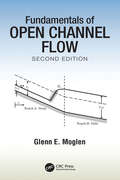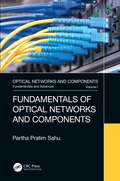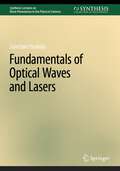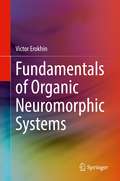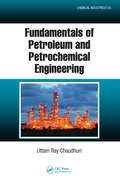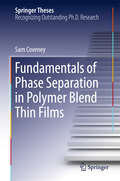- Table View
- List View
Fundamentals of Open Channel Flow
by Glenn E. MoglenThis second edition of Fundamentals of Open Channel Flow focuses on theory followed by clear, fully-solved examples, and practical computational tools such as spreadsheets and industry standard software. It builds on a foundation in fluid mechanics and offers the basics of a first course in open channel flow for senior undergraduates or graduate students: energy, momentum, friction, and gradually varied flow, both qualitative and quantitative. This edition provides more coverage of design applications, including culvert design, a wider range of channel shapes, and an update of the US Corps of Engineers’ HEC-RAS program. It shows how a few simple equations can solve a range of basic problems. The energy-depth and momentum-depth relationships are examined graphically and the book's website offers unique animations showing actual flow dynamics of some transient flow problems, as well as solutions to end-of-chapter problems and PowerPoint slides for instructors.
Fundamentals of Optical Computing Technology: Forward the Next Generation Supercomputer
by Xiujian Li Zhengzheng Shao Mengjun Zhu Junbo YangThis book presents the principles, experimental technologies, up-to-date research findings and applications of various optical-computing technologies and devices. It also discusses semiconductor multiple quantum well (MQW) photoelectronic devices, vertical-cavity surface-emitting lasers (VCSELs), lasers, micro optical elements and diffractive optical elements, optical storage, optical parallel interconnections, and optical-buffer technology as the main technologies for optical computing. Furthermore, it explores the potential of optical-computing technology. It offers those involved in optical design, photonics, and photoelectronic research and related industries insights into the fundamentals and theories of optical computing, enabling them and to extend and develop the functions of fundamental elements to meet the requirement of optical-computing systems.
Fundamentals of Optical Fiber Sensors (Wiley Series in Microwave and Optical Engineering #226)
by Zujie Fang Ken Chin Ronghui Qu Haiwen CaiThis book describes the latest development in optical fiber devices, and their applications to sensor technology. Optical fiber sensors, an important application of the optical fiber, have experienced fast development, and attracted wide attentions in basic science as well as in practical applications. Sensing is often likened to human sense organs. Optical fiber can not only transport information acquired by sensors at high speed and large volume, but also can play the roles of sensing element itself. Compared with electric and other types of sensors, fiber sensor technology has unique merits. It has advantages over conventional bulky optic sensors, such as combination of sensing and signal transportation, smaller size, and possibility of building distributed systems. Fiber sensor technology has been used in various areas of industry, transportation, communication, security and defense, as well as daily life. Its importance has been growing with the advancement of the technology and the expansion of the scope of its application, a growth this book fully describes.
Fundamentals of Optical Fiber Sensors (Wiley Series in Microwave and Optical Engineering #226)
by Zujie Fang Ken Chin Ronghui Qu Haiwen CaiThis book describes the latest development in optical fiber devices, and their applications to sensor technology. Optical fiber sensors, an important application of the optical fiber, have experienced fast development, and attracted wide attentions in basic science as well as in practical applications. Sensing is often likened to human sense organs. Optical fiber can not only transport information acquired by sensors at high speed and large volume, but also can play the roles of sensing element itself. Compared with electric and other types of sensors, fiber sensor technology has unique merits. It has advantages over conventional bulky optic sensors, such as combination of sensing and signal transportation, smaller size, and possibility of building distributed systems. Fiber sensor technology has been used in various areas of industry, transportation, communication, security and defense, as well as daily life. Its importance has been growing with the advancement of the technology and the expansion of the scope of its application, a growth this book fully describes.
Fundamentals of Optical Networks and Components
by Partha Pratim SahuThis book is intended as an undergraduate/postgraduate level textbook for courses on high-speed optical networks as well as computer networks. Nine chapters cover the basic principles of the technology and different devices for optical networks, as well as processing of integrated waveguide devices of optical networks using different technologies. It provides students, researchers and practicing engineers with an expert guide to the fundamental concepts, issues and state-of-the-art developments in optical networks. It includes examples throughout all the chapters of the book to aid understanding of basic problems and solutions. Presents basics of the optical network devices and discusses latest developments Includes examples and exercises throughout all the chapters of the book to aid understanding of basic problems and solutions for undergraduate and postgraduate students Discusses different optical network node architectures and their components Includes basic theories and latest developments of hardware devices with their fabrication technologies (such as optical switch, wavelength router, wavelength division multiplexer/demultiplexer and add/drop multiplexer), helpful for researchers to initiate research on this field and to develop research problem-solving capability Reviews fiber-optic networks without WDM and single-hop and multi-hop WDM optical networks P. P. Sahu received his M.Tech. degree from the Indian Institute of Technology Delhi and his Ph.D. degree in engineering from Jadavpur University, India. In 1991, he joined Haryana State Electronics Development Corporation Limited, where he has been engaged in R&D works related to optical fiber components and telecommunication instruments. In 1996, he joined Northeastern Regional Institute of Science and Technology as a faculty member. At present, he is working as a professor in the Department of Electronics and Communication Engineering, Tezpur Central University, India. His field of interest is integrated optic and electronic circuits, wireless and optical communication, clinical instrumentation, green energy, etc. He has received an INSA teacher award (instituted by the highest academic body Indian National Science Academy) for high level of teaching and research. He has published more than 90 papers in peer-reviewed international journals, 60 papers in international conference, and has written five books published by Springer Nature, McGraw-Hill. Dr Sahu is a Fellow of the Optical Society of India, Life Member of Indian Society for Technical Education and Senior Member of the IEEE.
Fundamentals of Optical Networks and Components
by Partha Pratim SahuThis book is intended as an undergraduate/postgraduate level textbook for courses on high-speed optical networks as well as computer networks. Nine chapters cover the basic principles of the technology and different devices for optical networks, as well as processing of integrated waveguide devices of optical networks using different technologies. It provides students, researchers and practicing engineers with an expert guide to the fundamental concepts, issues and state-of-the-art developments in optical networks. It includes examples throughout all the chapters of the book to aid understanding of basic problems and solutions. Presents basics of the optical network devices and discusses latest developments Includes examples and exercises throughout all the chapters of the book to aid understanding of basic problems and solutions for undergraduate and postgraduate students Discusses different optical network node architectures and their components Includes basic theories and latest developments of hardware devices with their fabrication technologies (such as optical switch, wavelength router, wavelength division multiplexer/demultiplexer and add/drop multiplexer), helpful for researchers to initiate research on this field and to develop research problem-solving capability Reviews fiber-optic networks without WDM and single-hop and multi-hop WDM optical networks P. P. Sahu received his M.Tech. degree from the Indian Institute of Technology Delhi and his Ph.D. degree in engineering from Jadavpur University, India. In 1991, he joined Haryana State Electronics Development Corporation Limited, where he has been engaged in R&D works related to optical fiber components and telecommunication instruments. In 1996, he joined Northeastern Regional Institute of Science and Technology as a faculty member. At present, he is working as a professor in the Department of Electronics and Communication Engineering, Tezpur Central University, India. His field of interest is integrated optic and electronic circuits, wireless and optical communication, clinical instrumentation, green energy, etc. He has received an INSA teacher award (instituted by the highest academic body Indian National Science Academy) for high level of teaching and research. He has published more than 90 papers in peer-reviewed international journals, 60 papers in international conference, and has written five books published by Springer Nature, McGraw-Hill. Dr Sahu is a Fellow of the Optical Society of India, Life Member of Indian Society for Technical Education and Senior Member of the IEEE.
Fundamentals of Optical Parametric Processes and Oscillations
by Alice M. TangThis study looks at the basic principles of optical parametric processes and recent results on the rapidly developing optical parametric device technology. The theoretical basis of stimulated and spontaneous optical parametric processes and detailed design considerations of optical parametric oscillators and amplifiers are discussed, followed by a review of the materials properties of the most important nonlinear optical crystals for such applications. It concludes with a review of the recent developments on practical low-repetition rate nanosecond optical parametric oscillators and broadly tunable high-repetition rate continuous-pulse-train femtosecond optical parametric oscillations from the uv to the mid ir.
Fundamentals of Optical Parametric Processes and Oscillations
by Alice M. TangThis study looks at the basic principles of optical parametric processes and recent results on the rapidly developing optical parametric device technology. The theoretical basis of stimulated and spontaneous optical parametric processes and detailed design considerations of optical parametric oscillators and amplifiers are discussed, followed by a review of the materials properties of the most important nonlinear optical crystals for such applications. It concludes with a review of the recent developments on practical low-repetition rate nanosecond optical parametric oscillators and broadly tunable high-repetition rate continuous-pulse-train femtosecond optical parametric oscillations from the uv to the mid ir.
Fundamentals of Optical Waves and Lasers (Synthesis Lectures on Wave Phenomena in the Physical Sciences)
by Sanichiro YoshidaThis book discusses light, its properties as an electromagnetic wave, interaction with matter, and laser as an optical device. The first part discussions include qualitative arguments such as pictorial representations of the wave dynamics and analogy to other oscillatory systems to facilitate an intuitive understanding of the topics. The second part reviews light-matter interaction. It introduces the light-matter interaction while introducing the particular behavior of light, known as the photon, reviewing various properties of light waves resulting from the interaction with matters including the propagation of light in media. The last two sections focus on the fundamentals of lasers and the practical uses of lasers, including several techniques to control the spatial and temporal characteristics of laser beams. This book discusses acoustic waves' characteristics so that we can deepen our understanding of acoustic waves.
Fundamentals of Optimization: Methods, Minimum Principles, and Applications for Making Things Better
by Mark FrenchThis textbook is for readers new or returning to the practice of optimization whose interest in the subject may relate to a wide range of products and processes. Rooted in the idea of “minimum principles,” the book introduces the reader to the analytical tools needed to apply optimization practices to an array of single- and multi-variable problems. While comprehensive and rigorous, the treatment requires no more than a basic understanding of technical math and how to display mathematical results visually. It presents a group of simple, robust methods and illustrates their use in clearly-defined examples. Distinct from the majority of optimization books on the market intended for a mathematically sophisticated audience who might want to develop their own new methods of optimization or do research in the field, this volume fills the void in instructional material for those who need to understand the basic ideas. The text emerged from a set of applications-driven lecture notes used in optimization courses the author has taught for over 25 years. The book is class-tested and refined based on student feedback, devoid of unnecessary abstraction, and ideal for students and practitioners from across the spectrum of engineering disciplines. It provides context through practical examples and sections describing commercial application of optimization ideas, such as how containerized freight and changing sea routes have been used to continually reduce the cost of moving freight across oceans. It also features 2D and 3D plots and an appendix illustrating the most widely used MATLAB optimization functions.
Fundamentals of Optomechanics (Optical Sciences and Applications of Light)
by Daniel Vukobratovich Paul YoderThis textbook will provide the fundamentals of optomechanics. Starting from the basics, this textbook will lead you through the opto-mechanical design process, discussing materials selection, principles of kinematic design, as well as mounting of windows, individual lenses, and multiple lenses. Techniques for mounting prisms, mirror performance, and design and mounting of mirrors will be included. Written by the two top scientists in the field, this stand-alone, student-friendly textbook has been course-tested and will include homework problems as well as a solutions manual for adopting professors.
Fundamentals of Optomechanics (Optical Sciences and Applications of Light)
by Daniel Vukobratovich Paul YoderWhen Galileo designed the tube of his first telescope, optomechanics was born. Concerned with the shape and position of surfaces in an optical system, optomechanics is a subfield of physics that is arguably as old as optics. However, while universities offer courses on the subject, there is a scarcity in textbook selections that skillfully and properly convey optomechanical fundamentals to aspiring engineers. Complemented by tutorial examples and exercises, this textbook rectifies this issue by providing instructors and departments with a better choice for transmitting to students the basic principles of optomechanics and allowing them to comfortably gain familiarity with the field’s content. Practicing optical engineers who engage in self-study and wish to enhance the extent of their knowledge will also find benefit from the vast experience of the authors. The book begins with a discussion of materials based on optomechanical figures of merit and features chapters on windows, prisms, and lenses. The authors also cover topics related to design parameter, mounting small mirrors, metal mirrors with a discussion of infrared applications, and kinematic design. Overall, Fundamentals of Optomechanics outfits students and practitioners with a stellar foundation for exploring the design and support of optical system surfaces under a wide variety of conditions. Provides the fundamentals of optomechanics Presents self-contained, student-friendly prose, written by top scientists in the field Discusses materials, windows, individual lenses and multiple lenses Includes design, mounting, and performance of mirrors Includes homework problems and a solutions manual for adopting professors
Fundamentals of Organic Neuromorphic Systems
by Victor ErokhinThis book describes the essential requirements for the realization of neuromorphic systems, where memristive devices play a key role. A comprehensive description to organic memristive devices, including working principles and models of the function, preparation methods, properties and different applications is presented. A comparative analysis of organic and inorganic systems is given. The author discusses all aspects of current research in organic memristive devices: fabrication techniques, properties, synapse mimicking circuits, and neuromorphic systems (including perceptrons), etc.Describes requirements of electronic circuits and systems to be considered as neuromorphic systems;Provides a single-source reference to the state-of-the-art in memristive devices as key elements of neuromorphic systems;Provides a comparative analysis of advantages and drawbacks between organic and inorganic devices and systems;Includes a systematic overview of organic memristive devices, including fabrication methods, properties, synapse mimicking circuits, and neuromorphic systems;Discusses a variety of unconventional applications, based on bio-inspired circuits and neuromorphic systems.
Fundamentals of Particle Accelerator Physics (Graduate Texts in Physics)
by Simone Di MitriThis book offers a concise and coherent introduction to accelerator physics and technology at the fundamental level but still in connection to advanced applications ranging from high-energy colliders to most advanced light sources, i.e., Compton sources, storage rings and free-electron lasers. The book is targeted at accelerator physics students at both undergraduate and graduate levels, but also of interest also to Ph.D. students and senior scientists not specialized in beam physics and accelerator design, or at the beginning of their career in particle accelerators.The book introduces readers to particle accelerators in a logical and sequential manner, with paragraphs devoted to highlight the physical meaning of the presented topics, providing a solid link to experimental results, with a simple but rigorous mathematical approach. In particular, the book will turn out to be self-consistent, including for example basics of Special Relativity and Statistical Mechanics for accelerators. Mathematical derivations of the most important expressions and theorems are given in a rigorous manner, but with simple and immediate demonstration where possible.The understanding gained by a systematic study of the book will offer students the possibility to further specialize their knowledge through the wide and up-to-date bibliography reported. Both theoretical and experimental items are presented with reference to the most recent achievements in colliders and light sources. The author draws on his almost 20-years long experience in the design, commissioning and operation of accelerator facilities as well as on his 10-years long teaching experience about particle accelerators at the University of Trieste, Department of Engineering and of Physics, as well as at international schools on accelerator physics.
Fundamentals of Perovskite Oxides: Synthesis, Structure, Properties and Applications
by Gibin George Sivasankara Rao Ede Zhiping LuoThis textbook entitled Fundamentals of Perovskite Oxides: Synthesis, Structure, Properties and Applications summarizes the structure, synthesis routes, and potential applications of perovskite oxide materials. Since these perovskite-type ceramic materials offer opportunities in a wide range of fields of science and engineering, the chapters are broadly organized into four sections of perovskite-type oxide materials and technology. Covers recent developments in perovskite oxides Serves as a quick reference of perovskite oxides information Describes novel synthesis routes for nanostructured perovskites Discusses comprehensive details for various crystal structures, synthesis methods, properties, and applications Applies to academic education, scientific research, and industrial R&D for materials research in real-world applications like bioengineering, catalysis, energy conversion, energy storage, environmental engineering, and data storage and sensing This book serves as a handy and practical guideline suitable for students, engineers, and researchers working with advanced ceramic materials.
Fundamentals of Perovskite Oxides: Synthesis, Structure, Properties and Applications
by Gibin George Sivasankara Rao Ede Zhiping LuoThis textbook entitled Fundamentals of Perovskite Oxides: Synthesis, Structure, Properties and Applications summarizes the structure, synthesis routes, and potential applications of perovskite oxide materials. Since these perovskite-type ceramic materials offer opportunities in a wide range of fields of science and engineering, the chapters are broadly organized into four sections of perovskite-type oxide materials and technology. Covers recent developments in perovskite oxides Serves as a quick reference of perovskite oxides information Describes novel synthesis routes for nanostructured perovskites Discusses comprehensive details for various crystal structures, synthesis methods, properties, and applications Applies to academic education, scientific research, and industrial R&D for materials research in real-world applications like bioengineering, catalysis, energy conversion, energy storage, environmental engineering, and data storage and sensing This book serves as a handy and practical guideline suitable for students, engineers, and researchers working with advanced ceramic materials.
Fundamentals of Petroleum and Petrochemical Engineering (ISSN)
by Uttam Ray ChaudhuriThe supply of petroleum continues to dwindle at an alarming rate, yet it is the source of a range of products- from gasoline and diesel to plastic, rubber, and synthetic fiber. Critical to the future of this commodity is that we learn to use it more judiciously and efficiently. Fundamentals of Petroleum and Petrochemical Engineering provides a holi
Fundamentals of Pharmaceutical Nanoscience
by Ijeoma F. Uchegbu, Andreas G. Schätzlein, Woei Ping Cheng and Aikaterini LalatsaNanoscience or the science of the very small offers the pharmaceutical scientist a wealth of opportunities. By fabricating at the nanoscale, it is possible to exert unprecedented control on drug activity. This textbook will showcase a variety of nanosystems working from their design and construction to their application in the field of drug delivery. The book is intended for graduate students in drug delivery, physical and polymer chemistry, and applied pharmaceutical sciences courses that involve fundamental nanoscience.The purpose of the text is to present physicochemical and biomedical properties of synthetic polymers with an emphasis on their application in polymer therapeutics i.e., pharmaceutical nanosystems, drug delivery and biological performance. There are two main objectives of this text. The first is to provide advanced graduate students with knowledge of the principles of nanosystems and polymer science including synthesis, structure, and characterization of solution and solid state properties. The second is to describe the fundamentals of therapeutic applications of polymers in drug delivery, targeting, response modifiers as well as regulatory issues.The courses, often listed as Advanced Drug Delivery and Applied Pharmaceutics; Polymer Therapeutics; or Nanomedicine, are designed as an overview of the field specifically for graduate students in the Department of Pharmaceutical Sciences Graduate Programs. However, the course content may also be of interest for graduate students in related biomedical research programs.These courses generally include a discussion of the major principles of polymer science and fundamental concepts of application of polymers as modern therapeutics. All courses are moving away from the above mentioned course names and going by ‘pharmaceutical nanoscience or nanosystems’. This area of research and technology development has attracted tremendous attention during the last two decades and it is expected that it will continue to grow in importance. However, the area is just emerging and courses are limited but they are offered.
Fundamentals of Phase Separation in Polymer Blend Thin Films (Springer Theses)
by Sam CoveneyThis work sheds new light on fundamental aspects of phase separation in polymer-blend thin films. A key feature underlying the theoretical models is the unification of one-dimensional thermodynamic phase equilibria with film evolution phenomena in two- and three dimensions. Initially, an established 'phase portrait' method, useful for visualising and calculating phase equilibria of polymer-blend films, is generalised to systems without convenient simplifying symmetries. Thermodynamic equilibria alone are then used to explain a film roughening mechanism in which laterally coexisting phases can have different depths in order to minimise free energy. The phase portraits are then utilised to demonstrate that simulations of lateral phase separation via a transient wetting layer, which conform very well with experiments, can be satisfactorily explained by 1D phase equilibria and a 'surface bifurcation' mechanism. Lastly, a novel 3D model of coupled phase separation and dewetting is developed, which demonstrates that surface roughening shadows phase separation in thin films.
Fundamentals of Photonics (Wiley Series in Pure and Applied Optics)
by Bahaa E. Saleh Malvin Carl TeichFundamentals of Photonics A complete, thoroughly updated, full-color third edition Fundamentals of Photonics, Third Edition is a self-contained and up-to-date introductory-level textbook that thoroughly surveys this rapidly expanding area of engineering and applied physics. Featuring a blend of theory and applications, coverage includes detailed accounts of the primary theories of light, including ray optics, wave optics, electromagnetic optics, and photon optics, as well as the interaction of light and matter. Presented at increasing levels of complexity, preliminary sections build toward more advanced topics, such as Fourier optics and holography, photonic-crystal optics, guided-wave and fiber optics, LEDs and lasers, acousto-optic and electro-optic devices, nonlinear optical devices, ultrafast optics, optical interconnects and switches, and optical fiber communications. The third edition features an entirely new chapter on the optics of metals and plasmonic devices. Each chapter contains highlighted equations, exercises, problems, summaries, and selected reading lists. Examples of real systems are included to emphasize the concepts governing applications of current interest. Each of the twenty-four chapters of the second edition has been thoroughly updated.
Fundamentals of Photonics (Wiley Series in Pure and Applied Optics #32)
by Bahaa E. Saleh Malvin Carl TeichFundamentals of Photonics A complete, thoroughly updated, full-color third edition Fundamentals of Photonics, Third Edition is a self-contained and up-to-date introductory-level textbook that thoroughly surveys this rapidly expanding area of engineering and applied physics. Featuring a blend of theory and applications, coverage includes detailed accounts of the primary theories of light, including ray optics, wave optics, electromagnetic optics, and photon optics, as well as the interaction of light and matter. Presented at increasing levels of complexity, preliminary sections build toward more advanced topics, such as Fourier optics and holography, photonic-crystal optics, guided-wave and fiber optics, LEDs and lasers, acousto-optic and electro-optic devices, nonlinear optical devices, ultrafast optics, optical interconnects and switches, and optical fiber communications. The third edition features an entirely new chapter on the optics of metals and plasmonic devices. Each chapter contains highlighted equations, exercises, problems, summaries, and selected reading lists. Examples of real systems are included to emphasize the concepts governing applications of current interest. Each of the twenty-four chapters of the second edition has been thoroughly updated.
Fundamentals of Physics and Chemistry of the Atmosphere
by Guido ViscontiThis book is an introductory course to the physics and chemistry of the atmosphere and to climate dynamics. It covers the basics in thermodynamics, fluid dynamics, radiation, and chemistry and explains the most intriguing problems that currently exist in the study of the atmospheres of the Earth and planets. A particular effort is made to approach the different topics intuitively. Among the themes covered are the most recent evolution concerning the chemistry of polluted troposphere, the global warming problem, and chaos and nonlinear theory.The book is almost completely rewritten in comparison to the previous edition, with a more logical organization of the chapters. The fundamentals of thermodynamics, radiation, fluid dynamics and chemistry are introduced in the first six chapters, including a new chapter on remote sensing. Also there is an additional chapter on geoengineering. A significant addition to the new edition, at the end of each chapter, are examples where the topics introduced in the chapter are further discussed with application to classical problems or new research items. Many of these examples are accompanied by computer programs. The most important updates deal with the theory of the general circulation, the methods to evaluate GCM, the detailed discussion of the urban troposphere and the chaos and nonlinear phenomena.
Fundamentals of Piezoelectric Sensorics: Mechanical, Dielectric, and Thermodynamical Properties of Piezoelectric Materials
by Jan Tichý Jirí Erhart Erwin Kittinger Jana PrívratskáPresents the fundamental physics of piezoelectric sensors.Only book with this scope Targeted to those engineers, phycisists and chemists who are involved in materials processing, device design and manufacturing.
Fundamentals of Plastic Optical Fibers
by Yasuhiro KoikePolymer photonics is an interdisciplinary field which demands excellence both in optics (photonics) and materials science (polymer). However, theses disciplines have developed independently, and therefore the demand for a comprehensive work featuring the fundamentals of photonic polymers is greater than ever. This volume focuses on Polymer Optical Fiber and their applications. The first part of the book introduces typical optical fibers according to their classifications of material, propagating mode, and structure. Optical properties, the high bandwidth POF and transmission loss are discussed, followed by an outline on the propagating mode characteristics and how they affect the performances of the fiber. The second part of the book reviews conventional materials of POFs and gives an overview on fabrication methods. This is followed by a survey of characterization methods. Based on the characteristics of optical communication systems, the last chapter will concentrate on the many advantages of POF in link and network design. Written by a top expert in the field, this is an invaluable resource for semiconductor physicists, materials scientists, polymer chemists, electrical engineers, and those working in the semiconductor industry.
Fundamentals of Plastic Optical Fibers
by Yasuhiro KoikePolymer photonics is an interdisciplinary field which demands excellence both in optics (photonics) and materials science (polymer). However, theses disciplines have developed independently, and therefore the demand for a comprehensive work featuring the fundamentals of photonic polymers is greater than ever. This volume focuses on Polymer Optical Fiber and their applications. The first part of the book introduces typical optical fibers according to their classifications of material, propagating mode, and structure. Optical properties, the high bandwidth POF and transmission loss are discussed, followed by an outline on the propagating mode characteristics and how they affect the performances of the fiber. The second part of the book reviews conventional materials of POFs and gives an overview on fabrication methods. This is followed by a survey of characterization methods. Based on the characteristics of optical communication systems, the last chapter will concentrate on the many advantages of POF in link and network design. Written by a top expert in the field, this is an invaluable resource for semiconductor physicists, materials scientists, polymer chemists, electrical engineers, and those working in the semiconductor industry.
